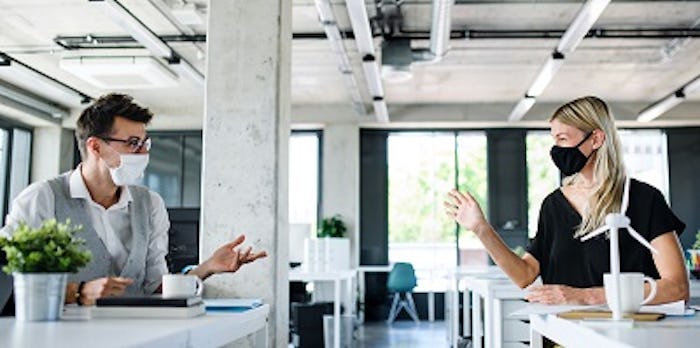
It seems like overnight the Corona-Virus Pandemic took charge of our lives. An unimaginable public event stoppage by the NBA, closing the doors on March Madness (valued at well over $800 million) made it clear that COVID-19 was a serious concern. Many other large public event cancellations followed, production slowed and massive furloughs and layoffs began. As a result, and in order to reinforce “social distancing”, companies across many industries were forced to restructure so employees could work from home. There are some good changes coming out of this shift in routine, including rethinking the design of the homespace and a re-evaluation of the office space. However, will these changes be enough?
Necessity and a novel challenge often spark innovation, and we have been in a crisis that demands adaptability, focus and economy in our approach to work. “The resulting change in how and where people work will have far-reaching implications for the built environment, sustainability, labor markets, transportation infrastructure, regional planning, tax and labor laws, and more.” (Source)

Though individuals may find some changes refreshing, businesses, from small to corporate giants, continue to struggle to move forward within a “social distance” business model. Out of nowhere new phrases like “essential workers” and “social distancing” became commonplace. More recently, people are taking a thoughtful look at the difference between “needs” and “wants”. Many Americans are seeing a rapid shift to working from home, and others are seeing a rapid change to the workplace they used to know. The pace of change has been phenomenal.
“This crisis has forced employers to do, inside a week, what Fortune 500 companies typically take months or even years to roll-out across their global portfolios,” says Dr. Anita Kamouri, Co-Founder of Iometrics, who has been helping organizations succeed with remote work practices and next-generation workplace strategies for two decades. (Source)

All this working at home has great benefits for society and corporations. Absolved of the morning routine needed to get ready for work, and the morning commute, employees save time they can dedicate to their work. Commute time, money spent on gas, parking hassle and the rush into the office, have been replaced by hours that tend to flex more, giving employees more time to complete tasks with less stress.
Some companies have been entertaining the idea that working from home can be incorporated into their business plans as highlighted in this CNBC article from early May. As local economies work on re-opening, many companies see the hardship, financially and from a design standpoint, in re-tooling the office for the post-COVID environment. Retail office space comes at a cost. Renewing it for the realities of today is challenging.
A best practices rebuild has yet to surface even as “de-densifying the office” is added to the list of new phrases. Some designers argue for larger spaces to maintain social distancing and others believe that staggering teams in the office is a better approach. From a systems standpoint, traffic flow can be controlled, and cubicles can make a comeback. Touchless technology can be employed liberally and anti-viral lighting and air handlers can be activated to cleanse the air and sanitize surfaces between shifts.
That said, at the end of the day, being at work is not just about employee safety, it is also about the conversations in the breakroom, the laughs around the coffee pot, and the feel of a good day at the office. Google created the micro-kitchen not only to offer convenience to their employees, but more importantly to encourage the casual conversations that can lead to a break-through. “It was about creating moments of serendipity…” (Laszlo Bock, former Head HR).
Applying that to the work environment in a more structured manner, IBM is looking at office space differently, “What we envision is the office becoming an innovation hub. You’ll come in for a purpose.” (Ginni Rometty, former CEO and current Executive Chairman, IBM)
Humans are social creatures – we need to see each other to better understand and hear each other, and to be able to communicate in relevant and impactful ways. Technology is amazing. It has given us many wonderful tools and results that have moved us light years ahead, even in just the past decade. Yet, there is still nothing that replaces the human bond we create when we are face-to-face. There is nothing else to replace the energy generated by personal and in-person communication. Nothing to replace the impact of our actions that result from that personal interaction and that exchange. Those “moments of serendipity” are priceless. In today’s socially distanced environment, the emotional adjustments may well be the true measure of success.

 © Copyright 2024, The True Life Companies. All Rights Reserved. Website Design by Kovach Marketing. Development & Hosting by Blue Tangerine.
© Copyright 2024, The True Life Companies. All Rights Reserved. Website Design by Kovach Marketing. Development & Hosting by Blue Tangerine.